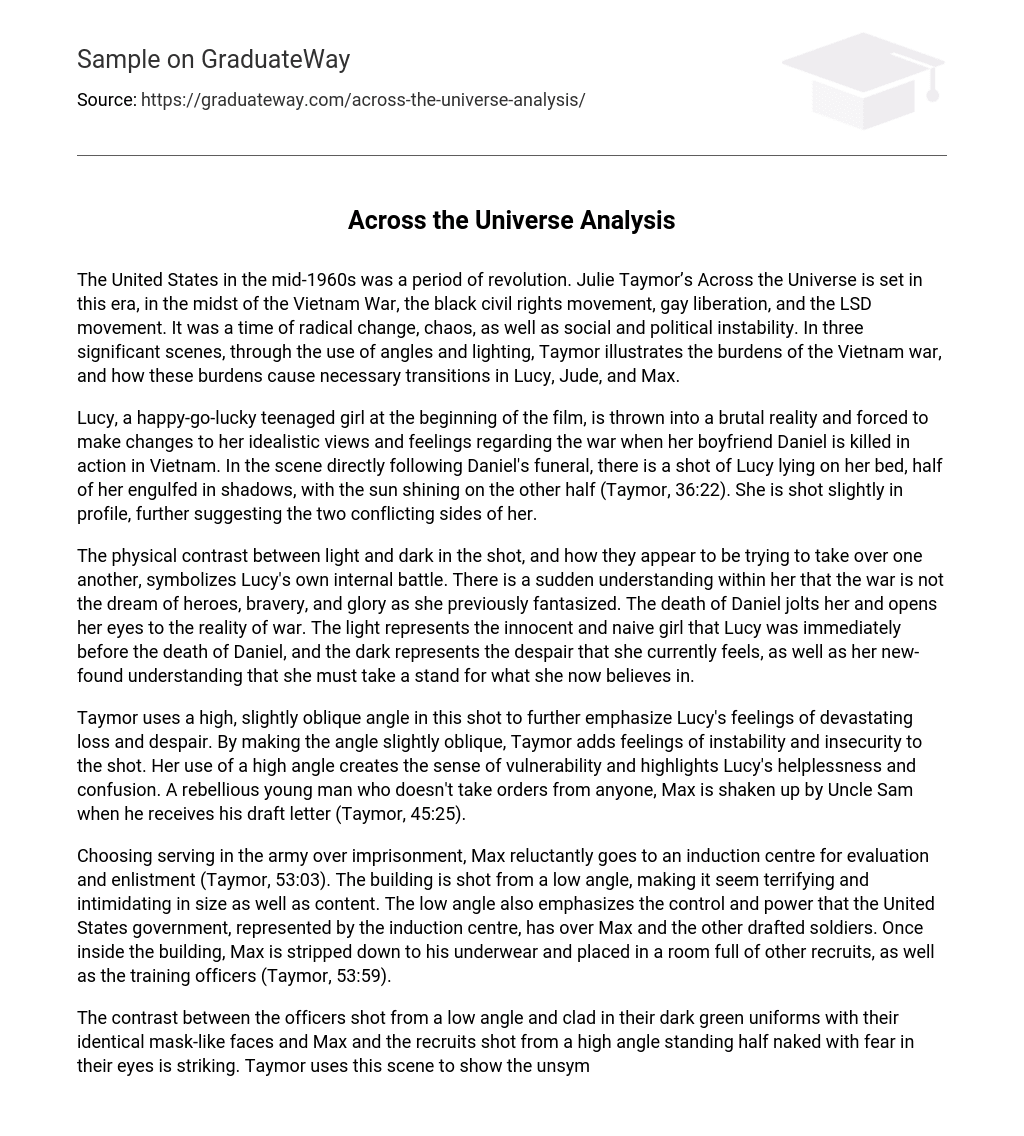The United States in the mid-1960s witnessed a period of revolution. Julie Taymor’s film, Across the Universe, is set during this time, amidst the Vietnam War, the black civil rights movement, gay liberation, and the LSD movement. This era was marked by radical change, chaos, and social and political instability. Through three significant scenes, Taymor effectively portrays the weight of the Vietnam War and its consequential impact on Lucy, Jude, and Max through the use of angles and lighting.
Lucy, a carefree teenager, starts the film with a joyful outlook on life. However, her perspective is shattered when her boyfriend Daniel dies in the Vietnam war. In the scene that follows Daniel’s funeral, we see Lucy lying on her bed. Half of her body is engulfed in shadows while the other half is illuminated by the sun (Taymor, 36:22). The shot of Lucy in partial profile highlights her internal conflict between her idealistic views and the harsh reality she now faces.
The shot showcases the physical contrast of light and dark, conveying Lucy’s internal struggle as they seem to compete with each other. This visual symbolizes her realization that war is not the heroic and glorious dream she once imagined, but rather a harsh reality. The death of Daniel shocks her and brings her to see the true nature of war. The light represents Lucy’s innocence and naivety before Daniel’s death, while the dark represents her current despair and newfound understanding that she must fight for her beliefs.
In this shot, Taymor uses a high angle that is slightly oblique to emphasize Lucy’s overwhelming sense of loss and despair. By tilting the angle slightly, Taymor adds a feeling of instability and insecurity to the shot. The use of a high angle also creates a sense of vulnerability and highlights Lucy’s helplessness and confusion. Max, a rebellious young man who doesn’t follow orders, becomes shaken when he receives his draft letter from Uncle Sam (Taymor, 45:25).
Max makes the reluctant decision to serve in the army rather than go to prison (Taymor, 53:03). The induction centre, shot from a low angle, creates a sense of fear and intimidation due to its size and significance. This camera angle also highlights the control and authority exerted by the United States government, symbolized by the induction centre, over Max and the fellow drafted soldiers. Upon entering the building, Max is required to undress down to his underwear and joins a room filled with other recruits and training officers (Taymor, 53:59).
The officers and Max and the recruits are portrayed in a contrasting manner in the film. The officers are shown from a low angle and are dressed in dark green uniforms with identical mask-like faces. On the other hand, Max and the recruits stand half-naked with fear in their eyes, captured from a high angle. This stark contrast highlights the unsympathetic control that the army has over these involuntary new soldiers. Immediately following this scene is another one where the new soldiers, still half-naked, carry the Statue of Liberty on their shoulders. Once again, this scene is shot from a high angle, emphasizing Max’s vulnerability and powerlessness in this situation (55:20-55:40).
Previously stubborn, Jude, an illegal immigrant from Liverpool, now acknowledges that he cannot maintain his former rebellious and carefree lifestyle without enduring the repercussions, namely imprisonment. As Lucy passionately demonstrates against the war that claimed her ex-partner’s life and currently engulfs Jude’s closest friend and her own brother, Jude grapples with the personal predicament of lacking a cause to champion. Consequently, he experiences a sense of worthlessness and insignificance amidst the ongoing turmoil.
Jude and Lucy have a heated argument towards the end of the film regarding Jude’s passive attitude towards the war. In his anger, Jude storms into the building where Lucy volunteers as a protestor and organizer for the Students for Democratic Reform. Jude is enraged and starts tearing up the room in an attempt to communicate his disagreement with the group’s protest methods (Taymor, 1:31:38-1:33:40). The next morning, Jude returns home only to find out that Lucy has left (Taymor, 1:38:10). Now, Jude not only lost his best friend Max but also the girl he loves, leaving him feeling like an outcast amidst all the chaos.
The scene of him slouched in a doorway after his discovery is captured from a high angle, showcasing the contrast between light and dark (Taymor, 1:38:41). Jude’s position in the center of the doorway, shot from above, symbolizes his powerlessness and feeling of being trapped amidst the chaos caused by the war and his personal relationships in New York City. This visual representation illustrates Jude’s lack of allegiance and prompts him to reevaluate his desires, ultimately leading him to choose love for Lucy as his side (Taymor, 1:41:30-1:41:50; 1:56:00-1:59:00). Taymor effectively highlights the challenges faced by Lucy, Max, and Jude, which compel them to reconsider their perspectives and self-identity, by employing film photography techniques and bringing these themes to life. Through her artistic prowess, Taymor explores the complexities of personal identity and internal conflict in the midst of the 1960s revolutionary era in her film Across the Universe.





